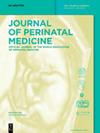减少产前基因检测决策中的决策冲突:产前护理开始时进行的父子干预的影响
IF 1.4
4区 医学
Q3 OBSTETRICS & GYNECOLOGY
引用次数: 0
摘要
目标 有关产前基因筛查和诊断检测的决策冲突和遗憾可能会对当前妊娠和未来的生育决策产生重要影响。确定减少与决定使用或拒绝这些选择相关的冲突的机制,对于优化患者咨询非常必要。方法 我们在产前检查开始时对共同决策工具(NEST)进行了分组随机对照试验。入组患者在检测时(QTT)和妊娠后三个月(QFF)完成了随访调查,包括决策冲突量表(DCS)。采用多变量线性混合效应模型对 DCS 总分进行了分析。结果 在所有参与者(502 人)中,有 449 人完成了 QTT 和 QFF 调查。参与者的平均年龄为(31.6±3.8)岁,其中大多数人在参与研究时是准妈妈(321 人;71.7%)。与 QTT(NEST 20.8 [5.0, 25.0] vs. 对照组 18.3 [3.3, 26.7];P=0.89)相比,NEST(干预)组和对照组在 QFF(NEST 13.3 [1.7, 25.0] vs. 对照组 16.7 [1.7, 25.0];P=0.24)时的 DCS 总分中位数都较低。与对照组相比,暴露于 NEST 的参与者在 QFF 时的决策冲突较低(β -3.889;[CI -7.341,-0.437];P=0.027)。结论 在产前护理开始时使用共同决策工具可减少产前基因检测的决策冲突。这种干预措施有可能为面临复杂和基于偏好的产前基因检测选择的患者提供一种重要的决策支持。本文章由计算机程序翻译,如有差异,请以英文原文为准。
Reducing decisional conflict in decisions about prenatal genetic testing: the impact of a dyadic intervention at the start of prenatal care
Objectives Decisional conflict and regret about prenatal genetic screening and diagnostic tests may have important consequences in the current pregnancy and for future reproductive decisions. Identifying mechanisms that reduce conflict associated with the decision to use or decline these options is necessary for optimal patient counseling. Methods We conducted a cluster-randomized controlled trial of a shared decision-making tool (NEST) at the beginning of prenatal care. Enrolled patients completed follow-up surveys at the time of testing (QTT) and in the second–third trimester (QFF), including the Decision Conflict Scale (DCS). Total DCS scores were analyzed using a multivariate linear mixed-effect model. Results Of the total number of participants (n=502) enrolled, 449 completed the QTT and QFF surveys. The mean age of participants was 31.6±3.8, with most parous at the time of study participation (n=321; 71.7 %). Both the NEST (the intervention) and control groups had lower median total DCS scores at QFF (NEST 13.3 [1.7, 25.0] vs. control 16.7 [1.7, 25.0]; p=0.24) compared to QTT (NEST 20.8 [5.0, 25.0] vs. control 18.3 [3.3, 26.7]; p=0.89). Participants exposed to NEST had lower decisional conflict at QFF compared to control (β −3.889; [CI −7.341, −0.437]; p=0.027). Conclusions Using a shared decision-making tool at the start of prenatal care decreased decisional conflict regarding prenatal genetic testing. Such interventions have the potential to provide an important form of decision-making support for patients facing the unique type of complex and preference-based choices about the use of prenatal genetic tests.
求助全文
通过发布文献求助,成功后即可免费获取论文全文。
去求助
来源期刊

Journal of Perinatal Medicine
医学-妇产科学
CiteScore
4.40
自引率
8.30%
发文量
183
审稿时长
4-8 weeks
期刊介绍:
The Journal of Perinatal Medicine (JPM) is a truly international forum covering the entire field of perinatal medicine. It is an essential news source for all those obstetricians, neonatologists, perinatologists and allied health professionals who wish to keep abreast of progress in perinatal and related research. Ahead-of-print publishing ensures fastest possible knowledge transfer. The Journal provides statements on themes of topical interest as well as information and different views on controversial topics. It also informs about the academic, organisational and political aims and objectives of the World Association of Perinatal Medicine.
 求助内容:
求助内容: 应助结果提醒方式:
应助结果提醒方式:


